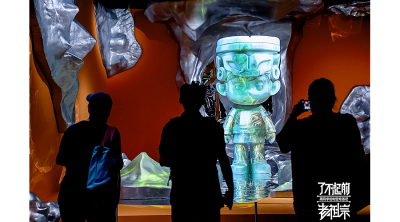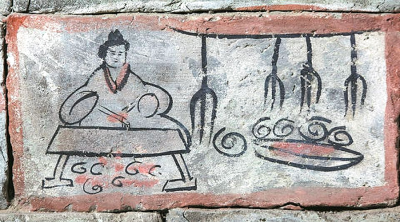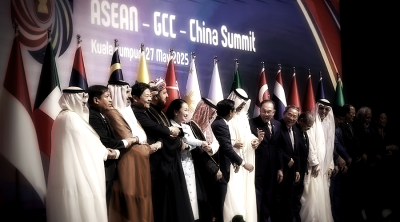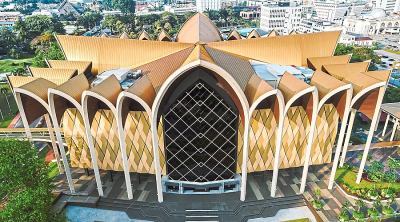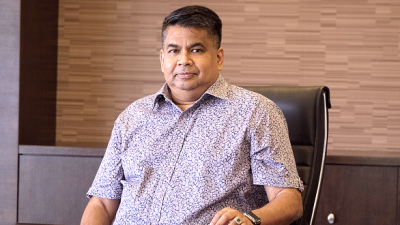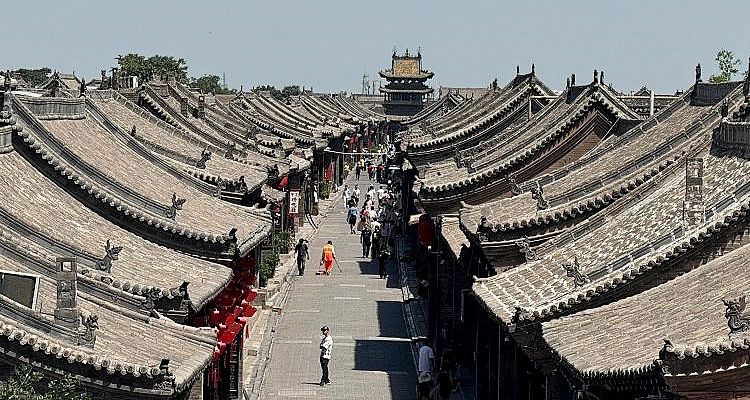
I recently read the book “The History of Chinese Architecture” by Liang Sicheng, and was shocked to find that much of China’s ancient architecture had had its origins within the borders of Shanxi Province.
Despite having gone through years of destructive wars, it is miraculous that many of those magnificent ancient structures have managed to survive until this day, almost intact.
As a matter of fact, we have to thank Liang and his wife Lin Huiyin for their unrelenting efforts in exploring, discovering, recording, compiling and preserving an enormous cache of valuable information on Shanxi’s ancient buildings, including Foguang Temple in Wutai Shan, the Nine-storey Wooden Pagoda in Ying County, Huayan Temple in Datong, as well as Yungang Grottoes — structures that have amazed architects from around the planet!
When Lin Huiyin, known for her meticulous attention to details, passed by the outskirts of Taiyuan City, she accidentally bumped into some truly beautiful roof tiles, and upon painstaking inspection, found that they belonged to the Jin Temple hailing from the Sung Dynasty!
Since Buddhism was first brought into China during the Eastern Han Dynasty, Shanxi had become a very prominent base for its flourishing. Owing to the rugged mountainous terrain here, many precious Buddhist relics have been impeccably preserved, including buildings, murals, statues and other forms of cultural legacies, as well as typical works from the Sui and Tang dynasties through to the latter years of Qing Dynasty, spanning thousands of years!
Much to our excitement, during this latest trip to Shanxi, I had the opportunity to see with my own eyes the 3,000-year-old ancient pine tee inside Jin Temple, standing solemnly outside the Hall of the Holy Mother, faithfully guarding generations of Chinese people.
The more undisclosed is Shanxi Province, the more is its intrinsic strength. Verily, there is no need for anyone to loudly proclaim its greatness to the rest of the world!
Shanxi Province is home to three of the world’s “super” heritage sites, and this alone speaks volumes of its cultural significance.
As if that’s not enough, the province also boasts the 2.25 square kilometre, 2,800-year-old Pingyao Ancient City, the Wutai Buddhist temple complex constructed more than 1,900 years ago (one of China’s four major Buddhist centres), as well as Yungang Grottoes constructed more than 1,500 years ago, among many other world-class historical sites there.
To be honest, I was completely bedazzled in this first rendezvous with the province so full of amazing stories!
The Yanmen Pass along the Shanxi section of the Great Wall of China has throughout history played host to some 22 Chinese emperors, 22 generals, five princesses, and even Chairman Mao Zedong! I was sighing whether I should have come and discovered this place much earlier!
I climbed up the Northern Hengshan Mountain to visit the 1,400-year-old Hanging Temple, overlooking the vertical cliffs, ravines and rapids underneath. I could feel a strong and powerful gust rushing past, sending many struggling to stand steadily. I was wondering why the craftsmen and Buddhist disciples ever came up with the idea of creating such an incredible edifice hanging atop a steep cliff more than a thousand years ago?
Anyway, this Hanging Temple remains the only temple that incorporates Buddhist and Taoist elements in China, and this alone is worthy of our one-hour queue to climb the mountain. I guess you should know this by now!
Additionally, I was also looking forward to visiting the tortoise-shaped Pingyao Ancient City which will instantly transport you back to the ancient China of more than 2,800 years ago. The entire city was laid out in a grid pattern with four main streets, eight smallest streets and 72 alleys. The main streets of South, East, West, Yamen and Chenghuang Streets crisscross to form the city’s major commercial thoroughfares.
Generally speaking, the city is made up of city walls, shops, streets, temples, residential houses, etc. to form a massive complex of nearly 4,000 ancient structures. During its heyday, the city was comparable in size and scale to ancient Rome!
Feeling exhausted, you can always hop into the local noodle shop or rest your weary feet at a music café. At night, you can enjoy the magnificent Youjian Pingyao show.
Along the South Main Street of Pingyao Ancient City, our guide Zhang Jie said empathically: This used to be ancient China’s Wall Street, controlling over 50% of the country’s financial sector. The earliest piao hao (bank) was Rishenchang established along West Main Street back in 1823 AD. These early financial institutions numbering more than a hundred dominated the financial sector back in those years, and were collectively called Shan Xi Bank by the Westerners. From Pingyao Ancient City, these piao haos started to gain worldwide reputation, carving their name as the pioneers of early Chinese, and even global, financial industry!
In the meantime, Shanxi is also known for its delicious Shanxi vinegar which is customarily used by the local residents to entertain their guests, and is an indispensable ingredient in the local cuisine.
Shanxi is also known for its many ways of preparing noodle dishes, including shaved noodle, tijian, hand-pulled noodle, etc. Zhang Jie had made the special arrangement for us to enjoy the unique Datong shaomai at Fenglinge Restaurant just outside Huayan Temple.
After a very satisfying meal at the restaurant, our guide mentioned that there are about 200 million people across China whose ancestry could be traced back to the province of Shanxi! As if that’s not enough, more than 800 family names in the Chinese world have had their origins from a giant locust tree in Shanxi’s Hongtong County! What’s going on here?
During the late Yuan and early Ming dynasties, Emperor Zhu Yuanzhang initiated the biggest human migration operation in China’s history. He assembled the overcrowded population of Shanxi Province under the giant locust tree in Hongtong County, instructing that only one member in a family of four, or two in a family of six, or three in a family of eight, could stay back while the rest had to be forcefully relocated to Henan, Shandong, Beijing, Tianjin, Hebei, Shanxi, Anhui and the three eastern provinces across much of China.
The operation involved nearly 1.5 million people and lasted almost 50 years!
The scale of the migration was unprecedented not just in China, but also rare in global migration history. It had far-reaching effects on human migration patterns, including the mass emigration of labourers during the Qing Dynasty to Southeast Asia.
This year marks the 34th anniversary of the Hongtong giant locust tree Qingming ceremony that brought together some 20,000 people from all over China as well as overseas Chinese, to pay homage to their ancestors. This probably explains the origin of the root of many Chinese people around the world from under the giant locust tree here in Shanxi Province!
Come on, folks! Looks like you might need to make a trip to Shanxi with me, too!
(Lee San is Founder and Group Executive Chairman of Apple Vacations. He has travelled to 132 countries, six continents, and enjoys sharing his travel stories and insights. He has also authored five books.)
ADVERTISEMENT
ADVERTISEMENT






